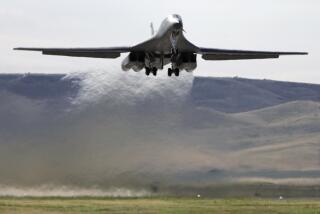U.S. Officials Visit WWII Wreck in China
- Share via
MAOER MOUNTAIN, China — On Aug. 31, 1944, after returning from a harrowing run over the South China Sea, Lt. James Miracle made this cryptic note in his diary about fallen comrades from his squadron in the 14th Air Force: “George Pierpont’s crew first mission, lost.”
Pierpont’s B-24 bomber and 10-member crew remained lost for 52 years, until the wreckage and remains were found this fall by peasants on a granite cliff high on this remote, mist-shrouded mountain in southern China.
On Tuesday, U.S. military forensic specialists made their first trip into the wilderness to identify the bodies, descending the slippery, steep mountainside on ropes and vines to the ledge sites where the twisted aluminum fuselage and bones of the dead airmen, all in their early 20s, were finally recovered.
This mission is being showcased by the United States and China as a sign of improving relations between the two powers. But for Jim Drager, 52, who was only 3 months old when he lost his father in the crash, the discovery of the aircraft was extraordinary.
“My father was just a citizen-soldier doing his job,” said Drager, a shipbuilder who lives in Fort Lauderdale, Fla. “It is just awesome that they found them after all these years. We thought they had been lost at sea.”
William A. Drager, 25, the son of a dairy farmer from Hackettstown, N.J., was a tail gunner in Pierpont’s crew, which was flying its first combat mission from its base in southern China in the final months of World War II.
In a letter written days before he disappeared from the mission to drop 500-pound acoustic mines in a harbor off Taiwan--then under Japanese occupation and known as Formosa--young Drager told his family: “God help us if we go down here . . . they’ll never find us because this is the most rugged country I’ve ever seen.”
Pierpont could not land his craft at its home in Liuzhou--one of six air bases under the command of Gen. Claire Chennault, the famed “Flying Tiger” 14th Air Force commander--because that site was under counterattack by the Japanese. The landing in nearby Guilin was delayed because of the fog and rain that are common in this mountainous region near the border of Hunan province.
Lost, inexperienced and flying a bomber that may have been damaged by antiaircraft fire in its raid off Taiwan, Pierpont slammed his plane into the side of the highest peak in southern China, the 7,068-foot Maoer--or “Little Cat”--mountain. The peak rises like a granite leviathan through layers of fog and mist over the hardscrabble countryside.
In his diary from the war years, Miracle, now 80 and living in Virginia Beach, Va., described the assault in which the Pierpont plane was lost as the “roughest mission in the theater.”
As the squadron of 11 craft approached Taiwan’s Takao Harbor, Miracle said the Japanese defenders illuminated the sky with radar-guided searchlights. “They would get one or two [lights] on an aircraft, and the antiaircraft would start in on them,” he recalled in a telephone interview.
His own plane was hit with 50-millimeter antiaircraft guns. Peering from the plexiglass bubble of his bombardier’s compartment, he thought he saw Pierpont’s plane get hit.
More than 1,000 U.S. aircraft were lost over all of China during the war; 100 remained that way in the rugged terrain or the shark-infested waters of the Taiwan Strait. That is, until Oct. 2, when two peasants, Jiang Jing, 29, and Pan Qibing, 33, discovered the Pierpont wreckage while searching for herbs.
The two men--who led a five-person U.S. military identification team to the site Tuesday--reported their finding to local authorities, who relayed it up the government hierarchy until it finally reached the office of Chinese President Jiang Zemin. Meeting with President Clinton in Manila in November, Jiang told Clinton of the discovery and pledged full government cooperation in its recovery. In December, China’s Defense Minister Chi Haotian presented U.S. officials with dog tags of some of the lost airmen listed in Defense Department records as members of the Pierpont crew.
Since then, both countries have pointed to the aircraft recovery--the first here since the finding of another American plane in a Tibetan glacier in 1994--as a sign of warming relations. “Consider it a first step in the stabilization,” said a Foreign Ministry official who accompanied China-based American journalists invited to the site.
As for Jim Drager, besides rediscovering a father he never really knew, he sees the recovery of the lost plane as “an opportunity for our country.”
“I hope they do it right,” said Drager, who said he plans to bury his father’s remains in the family cemetery in New Jersey. “After 52 years, we find these guys and we are going to bring them home. I really want closure on this.”
More to Read
Sign up for Essential California
The most important California stories and recommendations in your inbox every morning.
You may occasionally receive promotional content from the Los Angeles Times.










